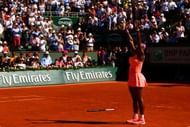With their wins in the finals of the Australian Open last week, Serena Williams and Roger Federer have cemented their place in tennis lore as the greatest Grand Slam champions in the open era. Serena broke her tie with Steffi Graf and now has 23 Grand Slam singles titles, and is only one short of Margaret Court’s all-time record of 24.
Federer, meanwhile, has even more breathing room at the top after winning his 18th Grand Slam title, with the difference between him and the active Nadal and retired Sampras standing at four. Born only about 50 days apart in 1981, there is a huge difference in their(Serena and Federer) tennis journey, statistically speaking.
Also read: An Australian Open that took us back to our childhood
While Federer turned professional in 1998, Serena turned pro at the tender age of 14 in 1995. The American won her first Grand Slam at the 1999 US Open while the Swiss won his first Grand Slam at Wimbledon in 2003.
We compare these two Champion of Champions’ tennis journeys from the time they won their first Grand Slam title:
The era of Roger (until 2007)
Roger Federer announced his arrival on the biggest stage of tennis at Wimbledon, 2003. He took his first Grand Slam home amongst seven other titles that year and finished the year ranked 2nd, albeit a very close 2nd to Andy Roddick.
The four years that followed were absolute magic. Federer won 11 Grand Slam titles over the next four years in a run that included three Grand Slams a year in three out of those four years. He finished the year ranked 1st in each of those four years and won 12 titles in 2006, whilst reaching the finals of all four Grand Slams.
In five years, from the beginning of 2003 to the end of 2007, the Swiss won 12 Grand Slams, nearly five Slams every two years. He also won 49 titles out of the 98 tournaments he took part in, which is essentially every second tournament he played in, and was inarguably, leagues ahead of any other player on the men’s circuit.
During the same period, Serena Williams, by her lofty standards (having the luxury of foresight), was still finding her way around the tennis circuit. In a 9-year period from 1999 to 2007, she finished a year as the top-ranked player only once – in 2002 – and won more than one Slam in a year only twice – in 2002 (3 Grand Slams), and 2003 (2 Grand Slams).
She won 28 titles out of the 94 tournaments she played in (at a rate of 0.3 titles per tournament). Moreover, she won less than one Grand Slam per year, having won eight titles in nine years.
What is interesting to note, though, is that Serena played only about 10 tournaments per year compared to the 17-odd tournaments that the top five players excluding her played during this 9-year stretch.
The break-point (end of 2007)
While it may seem unfair to look at nine years of Williams (from 1999 to 2007) and only five of Federer (2003 to 2007), there is a natural gap that occurs in that period. Federer lost his number 1 ranking to Nadal in 2008 while Serena made her comeback from injury and finished second at the end-of-year rankings in 2008, up 93 places from her 95th rank in 2006.
The queen of comebacks (2008-2016)
Having returned from injury, the American went berserk during this period. She won 43 titles in 137 tournaments, maintaining her clip of nearly 0.3 titles per tournament, but her performance on the biggest stages improved dramatically.
She finished as the top-ranked player in the world in four out of these nine years, and won 14 Grand Slam titles, amounting to more than one Slam a year on five occasions (3 in 2015 and 2 each in 2009, 2010, 2012 and 2013). Her Grand Slams per year ratio improved to 1.56, as she won nearly three Slams every two years. The younger Williams also started playing more tournaments in this period (around 15 tournaments a year), however, she was well below the top-5 average of 19.4.
The same timespan was not as friendly for Federer, though. Whether it was because of the arrival of fresh blood like Rafael Nadal, Novak Djokovic and Andy Murray or whether it was a drop in his own form from super-human to human or a combination of both or neither, any call would be speculative. In this timeframe, Federer finished on top of the rankings only once in 2009, which was also the only year in this period when he won multiple Grand Slam titles.
His Grand Slam conversion rate dropped steeply, with him winning a Grand Slam every two years. His win ratio in other tournaments dropped as well as he won 35 titles in 170 tournaments, winning only about a tournament for every five that he played in.
2016 saw the Swiss maestro undergo his first major surgery as a professional and he finished outside the top 10 for the first time since October 2002.
| Player | Roger Federer | Roger Federer | Serena Williams | Serena Williams |
| Time Span | 2003-2007 | 2008-2016 | 1999-2007 | 2008-2016 |
| Grand Slams | 12 | 5 | 8 | 14 |
| Grand Slams per year | 2.4 | 0.56 | 0.89 | 1.56 |
| Titles | 49 | 35 | 28 | 43 |
| Titles per tournament | 0.50 | 0.21 | 0.30 | 0.31 |
2017 has been great for both of these champions so far, with both securing the first Grand Slam of the year. While Serena is currently ranked No. 1 in the world, Federer has again broken into the top-10 on the men’s circuit.
Also read: Australian Open 2017: A tug at the heartstrings
Serena, meanwhile, has peaked with every passing year and there seems to be no stopping her. The way she has preserved her strength and conserved her body for the bigger matches is a thing of beauty.
Can Serena continue being Serena and can Federer take us on a stroll through memory lane? Only time will tell.
Who Are Roger Federer's Kids? Know All About Federer's Twins


